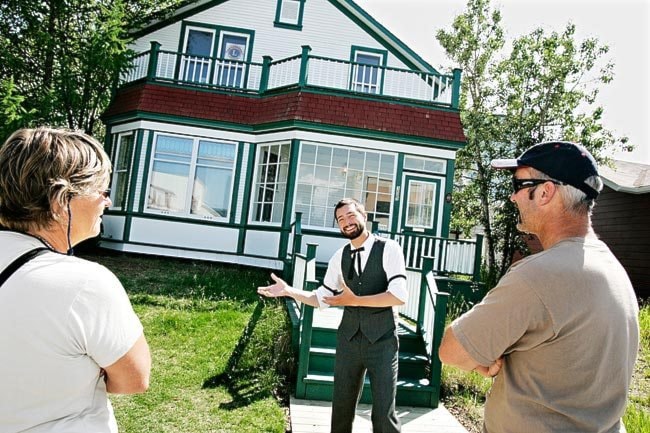The Yukon spends $5 million a year on tourism promotion and attracts 300,000 visitors a year.
Prince Edward Island spends $6 million, and gets 1.2 million people.
PEI marketers know who, where and how to market their visitors.
Yukon promotion is a shot in the dark, say some tourism operators.
The territory knows visitation is dropping, but that’s about it.
Every month, PEI tourism operators can monitor the occupancy rates for hotels and campgrounds across the province.
They also know, from province and state, where Canadian and American visitors came from.
To some extent, they can also discover why they visited.
The Yukon government relies on a trio of sketchy statistics, and intermittent surveys, to pin down Yukon visitation.
“Statistics are like bikinis; it’s amazing what they show, but what they don’t show is crucial,” said Leo Boon, manager of the Whitehorse branch of Cruise Canada RV rentals.
Border crossings, airport traffic and visits to tourism information centres are the only things the Yukon Department of Tourism uses to get a bead on the Yukon’s falling tourism market.
“For most jurisdictions, estimating tourism numbers has to be a very good estimate,” said Denny Kobayashi, manager of the Yukon government’s marketing operations for North America.
“If you combine five or six indicators all together, you get a pretty good idea,” he said.
Border crossings are easily skewed.
Every year, hundreds of tourists take the White Pass railway across the border into Carcross.
Then, they hop onto a bus that ferries them back into Skagway.
In the eyes of Yukon Tourism, White Pass border raids are counted as visits.
Furthermore, the triangular territory only shares one of its sides with an international border.
Any tourists coming in from the south and the east are undetected.
Even airport numbers provide little information about countries of origin.
“It is a bit difficult for us, in all fairness, because people who land in Vancouver clear customs in Vancouver and fly here on Air North,” said Kobayashi.
“We wouldn’t know if that’s a Japanese visitor,” he said.
Vague numbers throw a wrench into efforts to calculate the investment returns of Yukon Tourism promotion.
Annual conversion surveys shed some light.
The surveys follow up with visitors who requested a Yukon Vacation Guide.
“We ask them questions about their trip and how long they spent here, how much they spent—and that gives us a pretty good indicator,” said Kobayashi.
Every five years, a visitor-exit survey is conducted with tourists as they leave on outbound planes or by highway.
“We get a pretty good profile of visitors that are in the Yukon, how they decided to come here, what they did when they were here and how much they spent—every four to five years,” said Kobayashi.
Prince Edward Island, unlike the Yukon, has a hotel tax, which makes those numbers possible, said Kobayashi.
Yukon Tourism could simply keep a running poll of occupancy numbers—but hotels prefer to keep that data “close to the chest,” he said.
“Real Canadian Superstore doesn’t tell Super A what their sales are.”
“Last year, we ran at 94 per cent occupancy for June, and this year we ran at 89 per cent,” said Westmark Whitehorse manager Heather McIntyre last week.
The much-larger BC Department of Tourism takes data a step further by stratifying visitors by place of origin, intent of visit and length of stay.
A BC operator, for instance, would know that German tourists come to the province mainly to visit provincial parks.
Chinese visitors, on the other hand, come mainly to visit family.
How do they arrive?
Germans, primarily by rental car. The Chinese, by motorcoach.
BC spends $33 million on marketing ($7.46 per person).
While limited in responding to territorial changes, Yukon Tourism does respond to larger, Canada-wide market forces.
Recession-resilient Europe, for example, received particular attention this year from Yukon marketers.
Another $500,000 was put towards overseas campaigns in 2009.
“Knowing that the US was going to be hit hard, we made an enhanced investment in Europe,” said Kobayashi.
Marketing dollars were similarly pooled into the more-resilient Canadian market.
Operators have criticized the “adventure sport” focus of Yukon tourism advertising.
A glance at the government-run TravelYukon.ca reveals photos of climbers, kayakers and caribou.
However, climbers and hikers constitute only about six per cent of annual Yukon visitors.
“You show these animals which 99 per cent of people are never going to see—like muskox,” said Boon.
“What you don’t show, is infrastructure,” he said.
The bulk of travellers want to know “what the properties are like, what the hotel rooms are like, what the service is like, what the roads are like,” said Boon.
Pictures of canoes, bears and muskox are what bring travellers to the Yukon, said Kobayashi.
“People don’t come to the Yukon, or to Alaska, or to New Zealand or to Nunavut to find infrastructure,” he said.
If they want infrastructure, they can find information online, he said.
“I can almost guarantee you that they’re not going to say, ‘I wanna go there,’ when they see a picture of Main St. with a Starbucks on it,” said Kobayashi.
Of course, when markets fall and tourism dollars plummet, government tourism promoters are natural targets of criticism.
“It’s important to realize the limitations of it,” said Paul Nursey, executive director of strategy management for the Canadian Tourism Commission.
“No country, no city, no province has the ability to be everywhere at all times,” he said.
Contact Tristin Hopper at
tristinh@yukon-news.com
